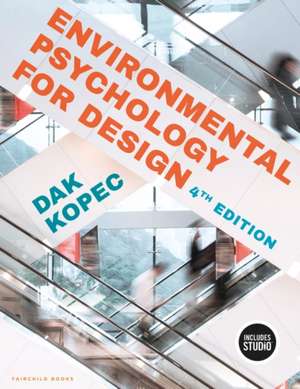Environmental Psychology for Design
Autor Dak Kopecen Limba Engleză Paperback – 20 mar 2024
Preț: 548.14 lei
Preț vechi: 695.26 lei
-21% Nou
Puncte Express: 822
Preț estimativ în valută:
104.88€ • 109.51$ • 86.81£
104.88€ • 109.51$ • 86.81£
Carte disponibilă
Livrare economică 14-28 martie
Preluare comenzi: 021 569.72.76
Specificații
ISBN-13: 9781501391866
ISBN-10: 1501391860
Pagini: 360
Ilustrații: 177 bw illus
Dimensiuni: 215 x 280 x 25 mm
Greutate: 0.98 kg
Ediția:4
Editura: Bloomsbury Publishing
Colecția Fairchild Books
Locul publicării:New York, United States
ISBN-10: 1501391860
Pagini: 360
Ilustrații: 177 bw illus
Dimensiuni: 215 x 280 x 25 mm
Greutate: 0.98 kg
Ediția:4
Editura: Bloomsbury Publishing
Colecția Fairchild Books
Locul publicării:New York, United States
Caracteristici
Includes flashcards and self-assessment quizzes in the student-facing STUDIO and comes with Instructor Resources.
Notă biografică
Dak Kopec is an Architectural Psychologist and Professor in the School of Architecture at the University of Nevada, Las Vegas. Dak has authored several books used by interior design educators, including four editions of Environmental Psychology for Design. He has also written the novel Broken Boys, a story that details the lives of young people coming to terms with their sexuality in the early 1990s.Dr. Kopec is a two-time Polsky Prize winner, is credited with researching, developing, and administering the first low residency graduate program focused on designs for human health at the Boston Architectural College, and has been awarded honorary Fellowship to ASID (HFASID). Dak served as a Visiting Professor at the University of Hawaii with a joint position in schools architecture and medicine, was listed as a Fulbright Specialist, and subsequently served two terms as a Fulbright Reviewer. In 2017 Dak won IDEC's Community Service Award for the design of a group home for people with developmental disabilities and early onset dementia. Today Dak is interested in promoting healthy spaces for the LGBTQ+ community by calling upon his diverse educational background in health sciences, psychology, and architecture. He is committed to design that promotes social equality for all people.
Cuprins
Chapter One IntroductionChapter Two Evidence Based ApproachesChapter Three Biology of SensationChapter Four Psychobiology of BehaviorChapter Five Sensation and PerceptionChapter Six The Human ConditionChapter Seven Cognitive InterpretationsChapter Eight Natural and Semi Natural EnvironmentsChapter Nine Retail, Restaurants, Cafes and Pubs Chapter Ten Early Childhood EducationChapter Eleven Senior Housing Chapter Twelve Long-Span StructuresChapter Thirteen DisabilitiesChapter Fourteen RetailChapter Fifteen Office Environments
